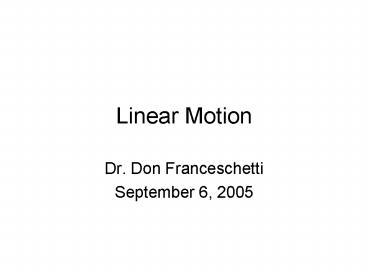Linear Motion PowerPoint PPT Presentation
1 / 15
Title: Linear Motion
1
Linear Motion
- Dr. Don Franceschetti
- September 6, 2005
2
Guide Questions
- 1. Is there any way to we tell if we are motion?
- 2. Is there a difference between speed and
velocity? - 3. Is there a difference between velocity and
acceleration? - 4. What is meant by free fall?
3
We are moving!
- 107,000 kilometers per hour with respect to the
sun - Faster with respect to center of milky way galaxy
(How do we know--Youll find out.) - Motion is relative. No meaning to absolute rest.
- Usually we mean relative to the Earths surface.
4
Units of Measurement
- The meter
- Originally the distance from the North pole to
the equator on the meridian passing through
Paris, France. - Then the distance between two marks on a Pt-Ir
rod. - Then a fixed number of wavelengths of a certain
wavelength of light - Now the distance traveled by light in a fixed
time.
5
Units of Measurement
- The second
- Short for the second minute part of an hour
- Originally 1/2600 of 1/24th of a mean solar day.
- Now time for a fixed number of vibrations of a Cs
atom. (atomic clock)
6
Speed
- Speed distance/time
- So units are meters/second (m/s.)
- E. g. 100 km/hr
- Instantaneous speed
- Average speed
- Total Distance Covered
- Time interval
7
Velocity
- Velocity is speed and direction, taken together.
E. g. 100 km/h due north. - Instantaneous velocity is usually meant.
- Average Velocity is
- Net displacement
- time interval
8
Acceleration
- Acceleration
- change in velocity
- time interval
- Measured in meters per second per second
- or m/s2
- Has both magnitude and direction
- Or in mixed units, e. g. 5 km/hrsec
- This is the one you feel
9
You have a (nonzero) acceleration if.
- Your speed changes as you move in a straight
line. - Your direction changes while your speed does not.
- Your speed and direction are both changing.
10
Galileo again
- Found that balls rolling down an inclined plane
did so wth constant acceleration - Velocity acceleration x time
- Measured from rest.
11
Free fall
- A body responding only to the gravitational pull
of other bodies is said to be in free-fall. - This means all other forces are negligible.
12
Little g
- Galileo showed that all bodies in free-fall near
the earths surface accelerate downward at 9.8
m/s2. - Call this g. Its best to remember as 10
meters per second every second. - Falling from rest vgt.
13
Freely Falling bodies
- How far
- D (1/2)gt2 from rest
- Or D v(average) x time, always true
14
Study problems
- Calculate the speed and distance covered at 1, 2,
3, 4, and 5, seconds by. - A lead brick dropped from rest.
- A rock tossed upward at 20 m/s.
- c) A rock thrown downward at 20 m/s.
15
For your further consideration
- Hewitt Ch 3.
- Review Questions 5, 6, 8, 11, 12
- Ex 1, 5, 6, 7, 27, 28, 29

